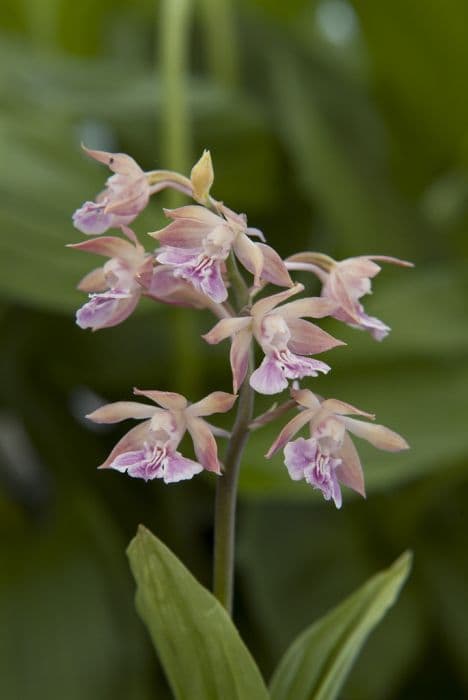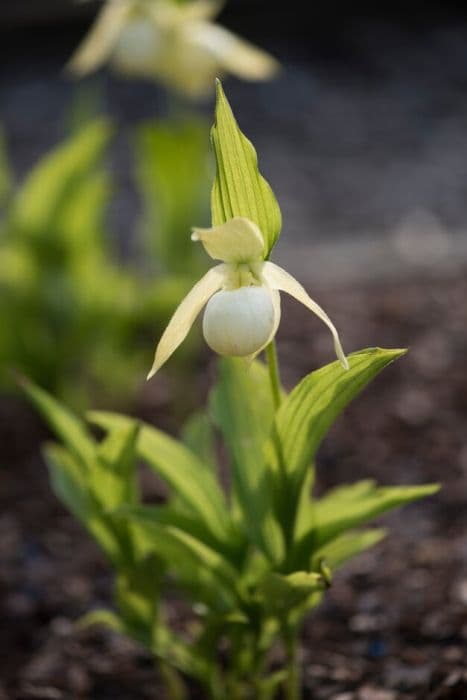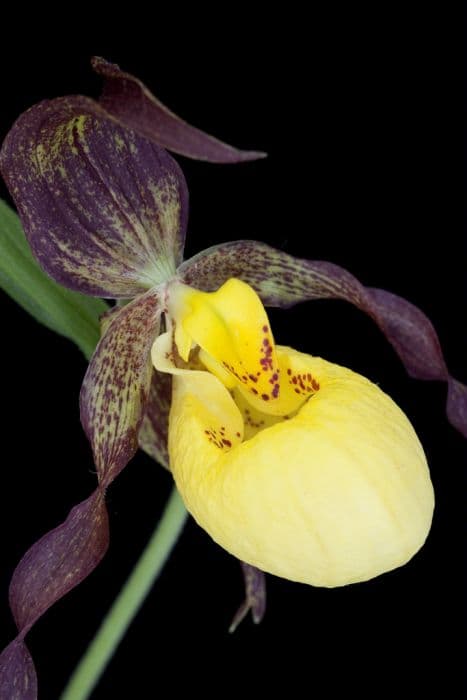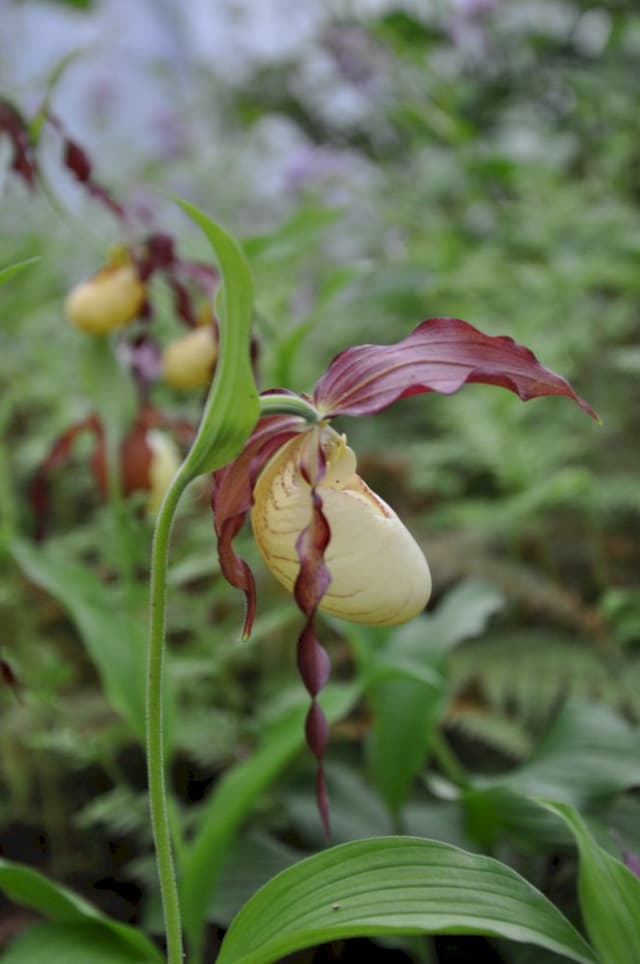King of the Andes Masdevallia veitchiana

ABOUT
The plant commonly known as the "King of the Masdevallias" is a striking species with a remarkable appearance. It bears eye-catching flowers that are the centerpiece of its allure. These blooms typically display a vibrant orange hue with reddish streaks or spots that decorate the petals, creating a fiery spectacle. The flowers exhibit a unique triangular shape due to the fusion of the lower petals, also known as the synsepal. Above this, the long, erect dorsal sepal stretches upwards, forming a visually prominent feature. The foliage of the plant is also notable, comprising glossy, deep green leaves. The leaves have an elongate shape and a smooth texture, growing in a lush, clustered manner that forms an attractive rosette. Overall, the plant presents a lush, vibrant visual display that makes it a desirable addition to any collection of enthusiasts.
About this plant
 Names
NamesSynonyms
King of the Masdevallias, Veitch's Masdevallia
Common names
Masdevallia princeps, Masdevallia tovarensis, Masdevallia veitchiana var. princeps, Masdevallia harryana, Masdevallia coccinea var. princeps
 Toxicity
ToxicityTo humans
The common name for Masdevallia veitchiana is King of the Masdevallias. This particular species of orchid is not known to be toxic to humans. Therefore, ingestion of this plant typically should not result in any symptoms of poisoning. However, it is generally advisable to avoid eating ornamental plants due to potential pesticide use and the risk of unknown allergies.
To pets
King of the Masdevallias is not recognized as toxic to pets. This means that if a pet were to ingest parts of the plant, they should not exhibit symptoms of poisoning specific to the ingestion of this plant. As with humans, precaution should be taken to prevent pets from consuming plants, both for the plants' sake and to avoid any potential gastrointestinal upset that might occur from eating non-food items.
 Characteristics
CharacteristicsLife cycle
Perennials
Foliage type
Evergreen
Color of leaves
Green
Flower color
Orange
Height
1 foot (30 cm)
Spread
1 foot (30 cm)
Plant type
Herb
Hardiness zones
9
Native area
Peru
Benefits
 General Benefits
General Benefits- Aesthetic Appeal: The King of the Andes Orchid adds a vibrant pop of color to any indoor or outdoor garden with its striking orange-red flowers.
- Habitat for Wildlife: It can provide nectar for various pollinators, helping support local biodiversity.
- Cultural Significance: Often used in horticultural shows and as collectibles, it holds ornamental value for enthusiasts and collectors.
- Educational Interest: Gardening with such exotic plants can provide educational opportunities about different plant species and their native habitats.
- Psychological Well-being: Caring for ornamental plants like the King of the Andes Orchid can reduce stress and increase feelings of calm and satisfaction.
- Horticultural Industry: It supports the horticultural trade, which includes nurseries, botanical gardens, and private collectors interested in rare and exotic plants.
 Medical Properties
Medical PropertiesThis plant is not used for medical purposes.
 Air-purifying Qualities
Air-purifying QualitiesThis plant is not specifically known for air purifying qualities.
 Other Uses
Other Uses- Ornamental display: The King of the Andes orchid is often used by orchid enthusiasts and collectors for ornamental displays due to its striking color and unique flower shape.
- Photography subject: This orchid species is a popular subject for botanical photographers, who wish to capture its vibrant orange-red hues and intricate structure.
- Bioindicators: They can serve as indicators of environmental health, especially in their native habitats, as they are sensitive to changes in air and soil quality.
- Educational tool: Botanical gardens and conservatories use the King of the Andes to educate the public about plant diversity and the importance of habitat conservation.
- Horticultural research: Researchers may study the plant as part of efforts to understand the growth patterns and reproduction of high-altitude orchid species.
- Conservation symbol: The plant is sometimes used as a symbol or flagship species in campaigns to promote the conservation of high mountain ecosystems.
- Plant competitions: They are frequently entered into orchid and plant competitions for their beauty and rarity, enhancing the status and diversity of such events.
- Flower arrangements: While not common, they can sometimes be found in high-end floral arrangements thanks to their striking appearance, albeit with careful handling due to their delicate nature.
- Therapeutic horticulture: Though not medically, the King of the Andes can be incorporated into therapeutic horticulture programs for relaxation and providing a calming, beautiful environment.
- Artistic inspiration: Its exotic look can inspire artists and crafters in their work, leading to plant-themed art, jewelry, or textile designs.
Interesting Facts
 Feng Shui
Feng ShuiThe King of the Andes is not used in Feng Shui practice.
 Zodiac Sign Compitability
Zodiac Sign CompitabilityThe King of the Andes is not used in astrology practice.
 Plant Symbolism
Plant Symbolism- Rarity: The Masdevallia veitchiana, commonly known as the Kite Orchid, is not a typical household plant and is often sought after by orchid enthusiasts. Its symbolism in rarity signifies uniqueness and preciousness in relationships or situations.
- Luxury: Orchids are generally associated with luxury and opulence due to their exotic appearance and the historical context where only the wealthy could afford them. The Kite Orchid's striking look upholds this association.
- Beauty and Perfection: With its exquisite and detailed flowers, the Kite Orchid represents beauty and the pursuit of perfection in various cultures.
- Strength and Resilience: Able to grow in challenging environments at high altitudes and with minimal soil, the Kite Orchid symbolizes the strength and resilience required to thrive against the odds.
 Water
WaterThe King of the Andes orchid prefers to be kept evenly moist but not waterlogged. This can be achieved by watering lightly but frequently, aiming to keep the potting medium damp. In practical terms, this usually means watering with about 4 to 6 ounces of water every 3 to 5 days, depending on environmental conditions such as temperature and humidity. It's crucial not to let the plant dry out completely, but also ensure good drainage to avoid root rot.
 Light
LightThe King of the Andes orchid thrives in bright, indirect light conditions, so placing it near an east or north-facing window where it can receive gentle morning sunlight or dappled light throughout the day is ideal. Avoid direct afternoon sun, which can scorch the leaves.
 Temperature
TemperatureThe optimal temperature range for the King of the Andes orchid is between 60 and 75 degrees Fahrenheit, which mimics its natural cool mountainous environment. It can tolerate short periods of temperatures slightly outside this range, but prolonged exposure to temperatures below 50 degrees or above 80 degrees Fahrenheit can be harmful.
 Pruning
PruningPruning the King of the Andes orchid is not typically necessary for plant health but can be done to remove any dead or yellowing leaves to maintain aesthetics and good hygiene. Prune sparingly, ideally after flowering is complete, using clean, sharp scissors to minimize any potential stress to the plant.
 Cleaning
CleaningAs needed
 Soil
SoilThe best soil mix for the King of the Andes Orchid (Masdevallia veitchiana) is a well-draining mix, containing fine fir bark, sphagnum moss, perlite, and charcoal. This mix ensures that the roots do not sit in water, which could cause rot. The pH should be slightly acidic, typically around 5.5 to 6.5, to mimic their native cloud forest conditions.
 Repotting
RepottingKing of the Andes Orchid should be repotted every one to two years or when the potting media breaks down and no longer drains well. It is important to use fresh soil mix when repotting to provide adequate aeration for the roots.
 Humidity & Misting
Humidity & MistingKing of the Andes Orchid thrives in high humidity conditions, ideally between 75% and 85%. If humidity falls below this level, the plant may suffer and not flower optimally. A humidifier or a humidity tray can be used to maintain these conditions indoors.
 Suitable locations
Suitable locationsIndoor
Keep high humidity, cool temps, indirect sunlight for King of the Andes Orchid.
Outdoor
Place in dappled shade with cool temps and high humidity for King of the Andes Orchid.
Hardiness zone
9-11 USDA
 Life cycle
Life cycleThe life cycle of the Masdevallia veitchiana, commonly known as King of the Masdevallias, begins with seed germination, which often requires symbiosis with a specific fungus to provide the necessary nutrients due to the seed’s minute size and lack of endosperm. The seeds develop into protocorms, which are the earliest stage of growth, resembling small bulbs or tubers before forming leaves and roots. During its vegetative growth phase, this epiphytic orchid develops a rosette of leaves and relies on a humid environment and specific light conditions to thrive but remains relatively small in size. Once mature, which can take several years, Masdevallia veitchiana produces distinctive, brightly colored flowers, often orange with streaks or spots; these flowers are pollinated by insects, leading to capsule formation. The capsules eventually dry and split open, releasing numerous tiny seeds to the surrounding environment, where they can be dispersed by wind or water. The plant continues to grow and flower annually, repeating the reproductive cycle and potentially living for many years under optimal conditions.
 Propogation
PropogationPropogation time
Spring-Early Summer
Masdevallia veitchiana, commonly known as the King of the Masdevallias, is an orchid species renowned for its striking flowers. Propagation is typically best done in the spring or early summer when the plant's growth is most active. The most popular method of propagation for the King of the Masdevallias is division, which involves separating new growth with its own roots from the parent plant. To propagate by division, carefully remove the orchid from its pot and identify a section of the plant with at least one pseudobulb and a healthy root system. Using a sterilized knife or scissors, gently separate the section from the main plant, ensuring that you do not damage the roots or pseudobulbs. After separation, pot the new division in a suitable orchid mix and maintain high humidity and indirect light to encourage the new plant to establish. With proper care, the new division should grow and eventually flower, adding to the collection of these extraordinary orchids.









